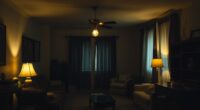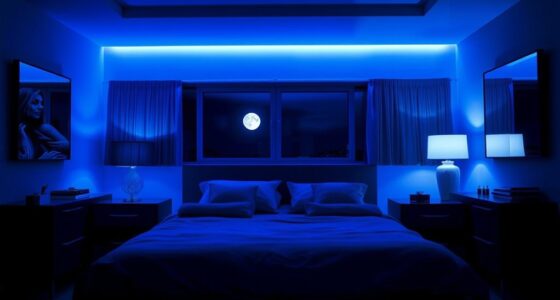To make a room feel huge, maximize natural light with sheer curtains and strategic window placements. Use mirrors opposite windows to bounce light and reflect open space. Incorporate layered lighting with dimmable fixtures and highlight architectural features. Opt for light colors on walls and ceilings to enhance brightness, and choose recessed or flush-mount fixtures for a clutter-free look. Adding accent lighting and light-filtered lampshades helps create depth. Keep exploring to uncover more designer tricks!
Key Takeaways
- Layer multiple light sources at different heights to add depth and dimension to the space.
- Use dimmers to adjust light intensity, creating contrast and preventing a flat, uniform look.
- Incorporate both overhead, task, and accent lighting for a layered, spacious feel.
- Position mirrors opposite windows or light sources to reflect light and visually expand the room.
- Choose light-colored walls and finishes to maximize light reflection and enhance openness.
Maximize Natural Light With Strategic Window Treatments

Maximizing natural light begins with choosing the right window treatments. Your window placement plays a pivotal role—avoid blocking light with heavy drapes or furniture. Instead, opt for curtain styles that let light flow freely, like sheer curtains or light fabric panels. Hang curtains close to the ceiling to create the illusion of taller windows and higher ceilings, amplifying brightness. Keep window treatments simple and unobtrusive to allow maximum sunlight to enter. If you have multiple windows, uniform curtain styles can unify the space and enhance the effect of openness. Remember, the goal is to reflect and diffuse light, so choose lightweight, airy fabrics that bounce light around the room. Incorporating natural materials in window treatments can also add to the farmhouse charm while enhancing light diffusion. Strategic window treatments can dramatically brighten your space and make it feel larger.
Use Mirror Placement to Reflect Light and Expand Space

Placing mirrors thoughtfully can reflect natural light and make your space feel larger. Try positioning them opposite windows or light sources to maximize brightness. Choosing reflective surfaces that complement your decor enhances the sense of openness throughout the room. Incorporating analytics cookies to monitor how different mirror placements impact room perception can help refine your design strategy.
Strategic Mirror Placement
Strategic mirror placement is one of the most effective ways to reflect light and create the illusion of a larger space. Proper mirror placement enhances reflection techniques, bouncing light across the room to brighten dark corners and open up confined areas. Position mirrors opposite windows or light sources to maximize natural light, making your space feel more expansive. You can also hang mirrors at eye level or slightly above to draw the eye outward, giving the impression of depth. Avoid placing mirrors behind furniture or in cluttered spots that disrupt reflection flow. Instead, focus on angles that reflect light and open up the room. With thoughtful mirror placement, you direct attention inward and outward, transforming your space into a brighter, more spacious environment. Incorporating contrast ratio considerations can further enhance the perception of space by ensuring that light and dark elements are balanced for maximum visual impact.
Maximize Natural Light
To make the most of natural light in your room, you should use mirrors to reflect and bounce sunlight throughout the space. Proper mirror placement enhances the effect of your windows, especially when considering window placement and size. Position mirrors opposite large windows to amplify incoming light, making your room feel more open and airy. If your windows are small, strategically placing mirrors can compensate by spreading light deeper into the room. Avoid blocking windows with furniture or curtains, as this limits natural brightness. With thoughtful mirror placement, even rooms with limited window size can appear larger and brighter.
| Window Placement | Effect on Light |
|---|---|
| Facing east | Morning brightness |
| Facing west | Afternoon warmth |
| High placement | Distributes light evenly |
| Large windows | Maximize daylight |
| Small windows | Use mirrors to amplify light |
Reflective Surface Choices
Choosing the right reflective surfaces can substantially boost your room’s brightness and sense of space. Proper mirror placement amplifies light and creates the illusion of depth, making your room feel larger. To maximize this effect, position mirrors opposite windows or light sources to bounce natural and artificial light throughout the space. Use large, strategically placed reflective surfaces to draw the eye inward and expand the room visually. Avoid cluttering with too many small mirrors, which can create chaos instead of spaciousness. Instead, focus on key placements that optimize light reflection and create a seamless flow. Remember, well-chosen reflective surfaces are a simple yet powerful trick to make any room feel more open and inviting.
- Place mirrors opposite windows for maximum light reflection
- Use full-length or large mirrors to create depth
- Avoid cluttered arrangements to maintain a sleek look
Incorporate Layered Lighting for Depth and Brightness

You can make your room feel more spacious by using multiple light sources at different levels. Vary the light intensity to create a sense of depth and keep the space feeling bright without overwhelming it. This layered approach adds dimension and enhances the overall openness of your room. Incorporating lighting tricks commonly used by designers can further optimize the visual impact.
Multiple Light Sources
Incorporating multiple light sources can dramatically transform a room, creating a sense of depth and making the space feel larger. By layering different lights, you enhance the ambient glow and highlight various areas, which tricks the eye into perceiving more space. Use a mix of overhead, task, and accent lighting to add dimension. Adjusting color temperature helps set the mood: warmer tones make the room cozy, while cooler ones open it up. Combining these layers makes a room feel more dynamic and inviting. Additionally, understanding sound vibrations can influence overall ambiance, as the right combination of auditory and visual elements enhances the perception of space.
Vary Light Intensity
Varying light intensity is essential for creating a layered lighting scheme that adds depth and brightness to a room. Using dimming techniques allows you to adjust light levels easily, enhancing light contrast and preventing a space from feeling flat or overly bright. By combining brighter task lighting with softer ambient sources, you create visual interest and a sense of spaciousness. Strategic dimming helps highlight architectural features or artwork, making the room feel larger. It also enables you to change the atmosphere throughout the day, from vibrant to cozy. Incorporating multiple light intensities ensures your space isn’t uniformly lit, which can make it appear smaller. Instead, you craft a dynamic environment that feels open, inviting, and expansive. Additionally, understanding self watering plant pots can help you maintain lively greenery that further enhances the perception of space and freshness in your room.
Choose Light Colors for Walls and Ceilings to Enhance Light Reflection
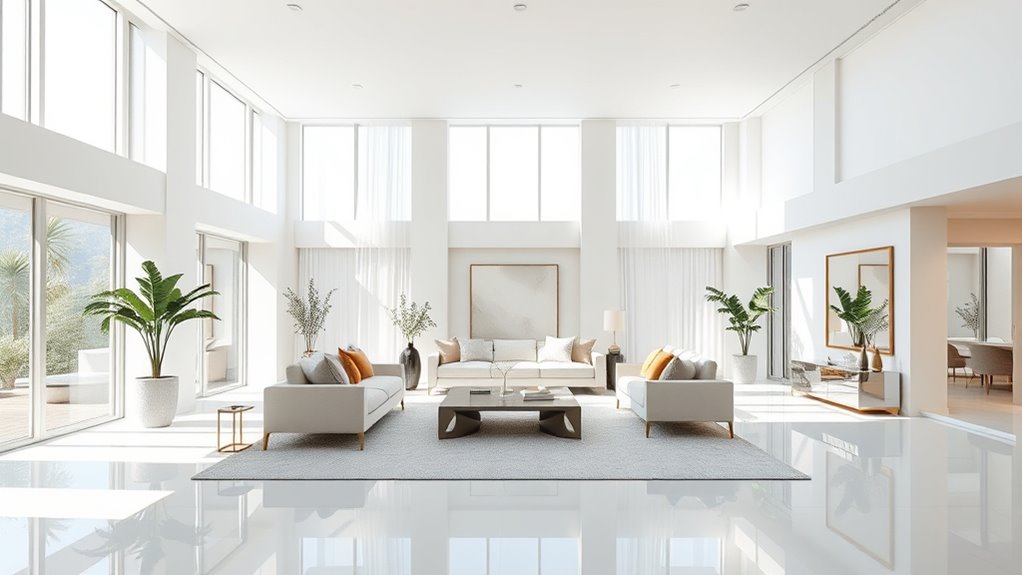
Light-colored walls and ceilings reflect more natural and artificial light, making a room feel brighter and more expansive. When selecting your color palette, opt for soft whites, creams, or pastels to maximize reflection. Lighter shades help bounce light throughout the space, enhancing the sense of openness. Pay attention to wall finishes—matte finishes reduce glare, while semi-gloss or satin finishes can reflect more light. Incorporate these tips:
Light-colored walls and ceilings enhance brightness and create a spacious, open feel in any room.
- Use pale, neutral colors for walls and ceilings to boost light reflection
- Choose wall finishes that complement your color palette for superior brightness
- Avoid dark or heavily textured surfaces that absorb light and create a smaller feel
- Selecting light-reflective finishes can further improve light distribution and amplify the room’s sense of spaciousness.
Install Recessed and Flush-Mount Fixtures to Minimize Clutter

Installing recessed and flush-mount fixtures helps create a clean, streamlined look by reducing visual clutter. Recessed lighting is installed into the ceiling, making it less obtrusive and freeing up space visually. Similarly, flush mount fixtures sit close to the ceiling, eliminating hanging cords or bulky designs that can make a room feel cramped. These fixtures provide ample light without breaking up the ceiling line or adding unnecessary visual noise. By choosing recessed lighting and flush mount fixtures, you keep your ceiling surfaces clear and uniform, which enhances the sense of openness. This minimalist approach directs attention to the room’s layout and natural features rather than the fixtures themselves, helping your space feel larger and more cohesive. Proper lighting design is essential for maximizing a room’s perceived size and creating an inviting atmosphere.
Utilize Task Lighting to Highlight Key Areas and Create Depth

Using task lighting effectively creates focused illumination zones that draw attention to key areas. You can accentuate architectural features and add depth by layering different light sources. This approach makes your space feel larger and more dynamic.
Focused Illumination Zones
To make a room feel larger, you can strategically use task lighting to create focused illumination zones that draw attention to key areas. By honing in on specific spots, you emphasize their importance and add depth to the space. Focused zones help break up large areas, making the room feel more dynamic. Use targeted lighting to highlight reading nooks, workspaces, or decorative features. This technique directs the eye and creates visual layers, enhancing the room’s sense of size. Additionally, understanding lighting techniques can further optimize spatial perception. Highlight artwork or shelves to add dimension, use adjustable lamps for flexible focused zones, and illuminate workspaces or seating areas to define spaces clearly.
Accent Architectural Features
Highlighting architectural features with task lighting can dramatically enhance a room’s sense of depth and dimension. By strategically placing lighting fixtures to accentuate architectural details and built-in features, you draw attention to the room’s unique design elements. For instance, wall-mounted spotlights can illuminate moldings, arches, or textured walls, creating striking visual contrasts. Under-cabinet or shelf lighting can showcase built-in units, adding layers of interest. These focused lights not only highlight key areas but also add depth by casting subtle shadows that give the space a more dynamic feel. When used thoughtfully, accent lighting on architectural details transforms ordinary features into focal points, making your room appear larger and more inviting without overwhelming the space. Additionally, understanding the impact of lighting design techniques can help you optimize the effects of your accent lighting to maximize perceived space.
Layered Light Effects
Layered lighting creates a dynamic environment that enhances a room’s perceived size by emphasizing its key areas. By combining different light sources, you can add depth and dimension. Use task lighting to highlight focal points like artwork or workspaces, making them stand out. Incorporate ambient glow with warm or cool color temperatures to set the mood and expand the space visually. Adjusting the layers allows you to control the room’s atmosphere and prevent harsh shadows. This technique draws attention to specific zones, making the room feel larger and more inviting.
- Use focused task lighting to highlight important areas
- Vary ambient glow with warm or cool color temperature
- Combine layered lights for depth and visual interest
Add Accent Lighting to Draw Attention and Create Visual Interest

Adding accent lighting is an effective way to draw attention to specific features in your room and create visual interest. By highlighting artwork, architectural details, or decorative objects, you can focus the eye and add depth to your space. Use spotlights or track lighting to emphasize these elements, making your room appear more dynamic and engaging. Accent lighting helps break up uniform illumination, adding layers that enhance the perception of space. When strategically placed, it guides the eye naturally throughout the room, giving it a more expansive feel. Keep in mind that the goal is to create focal points without overwhelming the space. With well-placed accent lighting, your room will feel more inviting, lively, and visually interesting.
Opt for Transparent or Light-Filtered Lampshades
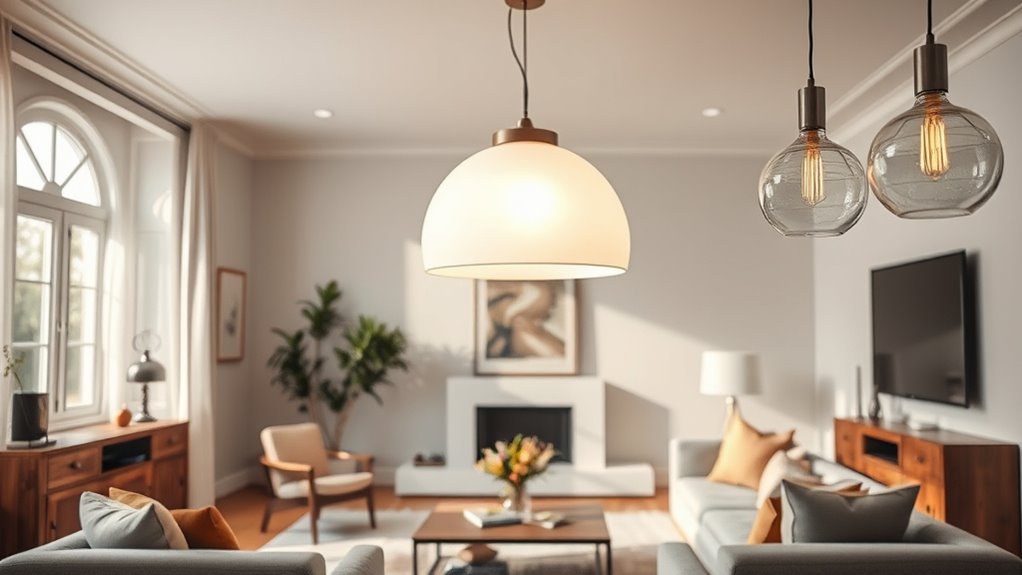
Choosing transparent or light-filtered lampshades can considerably enhance the sense of space in your room. Translucent lampshades, such as those made of frosted glass or fabric, diffuse light softly, preventing harsh shadows and creating an open, airy feel. Light filtering fixtures allow light to pass through gently, reducing cluttered shadows and making the room appear larger. These lampshades help maintain visual flow and avoid heavy, bulky look. When selecting lighting, opt for fixtures that maximize light diffusion without sacrificing brightness. This approach keeps your space feeling open and inviting.
- Use translucent lampshades to soften and spread light evenly
- Choose light-filtering fixtures to reduce shadows and glare
- Avoid opaque or dark-colored shades that shrink the visual space
Use Vertical and Horizontal Light Sources to Eliminate Shadows
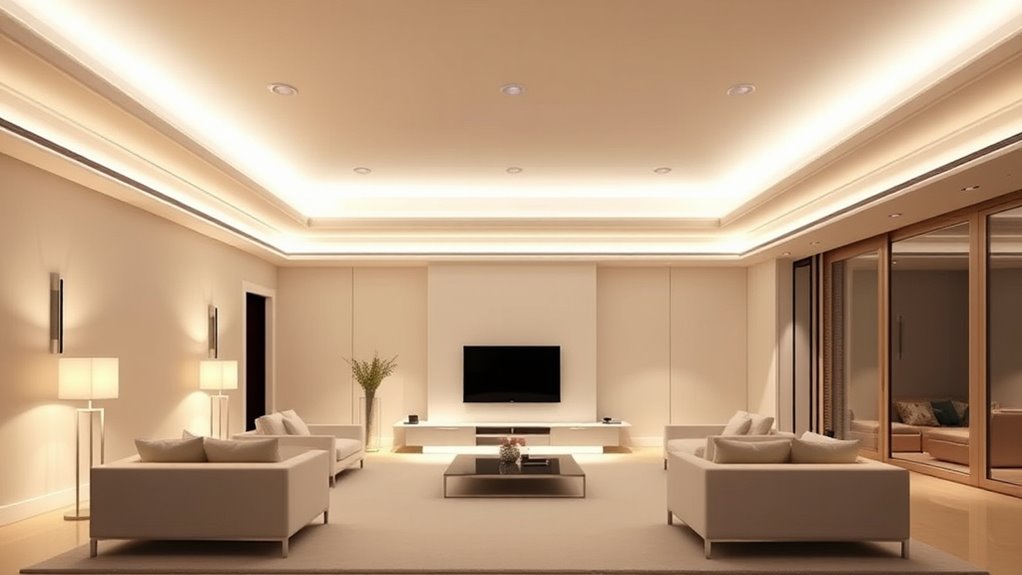
Using both vertical and horizontal light sources is an effective way to eliminate shadows and make your room feel more spacious. This approach enhances shadow elimination through strategic light layering, reducing dark corners and creating a more uniform glow. Vertical lights, like tall floor lamps or wall-mounted fixtures, brighten high and shadow-prone areas. Horizontal sources, such as ceiling lights or table lamps, fill in lower zones and eliminate side shadows. Combining these angles ensures even illumination, making your space appear larger. To visualize this, consider the table below:
| Vertical Light Sources | Horizontal Light Sources |
|---|---|
| Wall-mounted sconces | Ceiling fixtures |
| Tall floor lamps | Table lamps |
| Vertical strip lights | Recessed lighting |
This layered lighting setup maximizes shadow elimination and enhances the room’s perceived size.
Incorporate Dimmers to Control Light Intensity and Ambiance
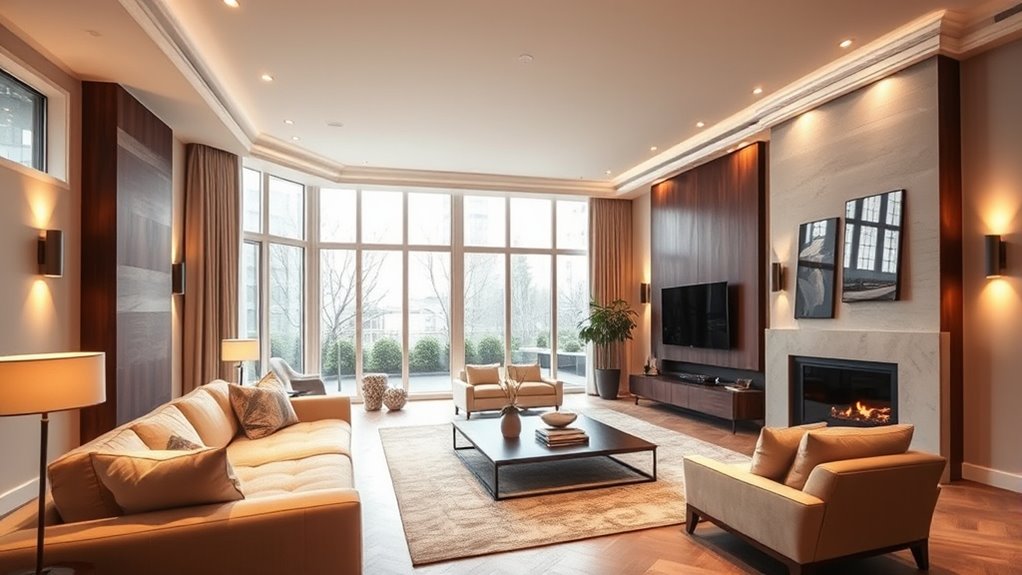
Incorporating dimmer switches into your lighting setup gives you precise control over light intensity and ambiance, allowing you to adapt the room’s mood instantly. With dimmer switches, you can easily create mood lighting that makes your space feel larger and more inviting. Adjust the brightness to highlight certain areas or soften the overall atmosphere, making the room appear more open.
- Customize lighting levels for different activities or times of day
- Use lower settings to make spaces feel cozy yet spacious
- Highlight architectural features with targeted dimming
Frequently Asked Questions
How Can I Make Small Rooms Appear Larger With Lighting?
To make small rooms appear larger, you should maximize natural light by keeping windows unobstructed and using light-colored curtains. Incorporate layered lighting with a combination of ambient, task, and accent lights to create depth and avoid shadows. Use wall sconces or recessed lighting to brighten corners, making the space feel open. By enhancing natural light and layering your lighting, you’ll create a brighter, more expansive atmosphere in your small room.
What Lighting Techniques Work Best for Low-Ceilinged Spaces?
In low-ceilinged spaces, you should focus on lighting techniques that create the illusion of height. Use ambient lighting to brighten the room evenly, avoiding heavy fixtures that clutter the space. Incorporate accent lighting to highlight walls or architectural features, drawing the eye upward. Recessed or flush-mount fixtures work best, as they save space and keep the ceiling feeling open. This approach makes your room appear more spacious and inviting.
How Do Color Temperatures Affect Room Size Perception?
You notice that warmer color temperatures create a cozy, intimate feel, making a room seem smaller, while cooler temperatures give an ambient glow that opens up the space. By using high color contrast, you enhance this effect, making the room appear larger or smaller depending on your choice. Adjusting these temperatures strategically can manipulate perception, helping your room feel more expansive or snug based on your preference.
Can Smart Lighting Enhance Room Spaciousness?
Smart lighting can markedly enhance your room perception by adjusting brightness and color temperature to create a sense of spaciousness. You can easily control your lights with apps or voice commands, opening up the space visually. By dimming lights or using cooler tones during the day, you make the room feel larger. Smart lighting offers flexible, dynamic options that help your space look and feel more expansive and inviting.
What Are Common Lighting Mistakes That Make Rooms Feel Smaller?
You might make your room feel smaller by poor lighting placement, like placing fixtures too low or in dark corners. Choosing heavy or overly bright fixtures can also shrink the space visually. To avoid this, opt for well-placed, unobtrusive lighting and select fixtures that blend seamlessly into your decor. Proper lighting enhances openness, so think carefully about where and what you light to keep your space feeling larger.
Conclusion
By mastering these lighting tricks, you transform your space into an expansive haven, where brightness invites openness and shadows add depth. While clever strategies make your room feel larger, they also remind you that true spaciousness isn’t just about size but the interplay of light and perception. Embrace these techniques, and you’ll discover that a well-lit room feels both grand and inviting, proving that sometimes, less space is more about how you illuminate it.

